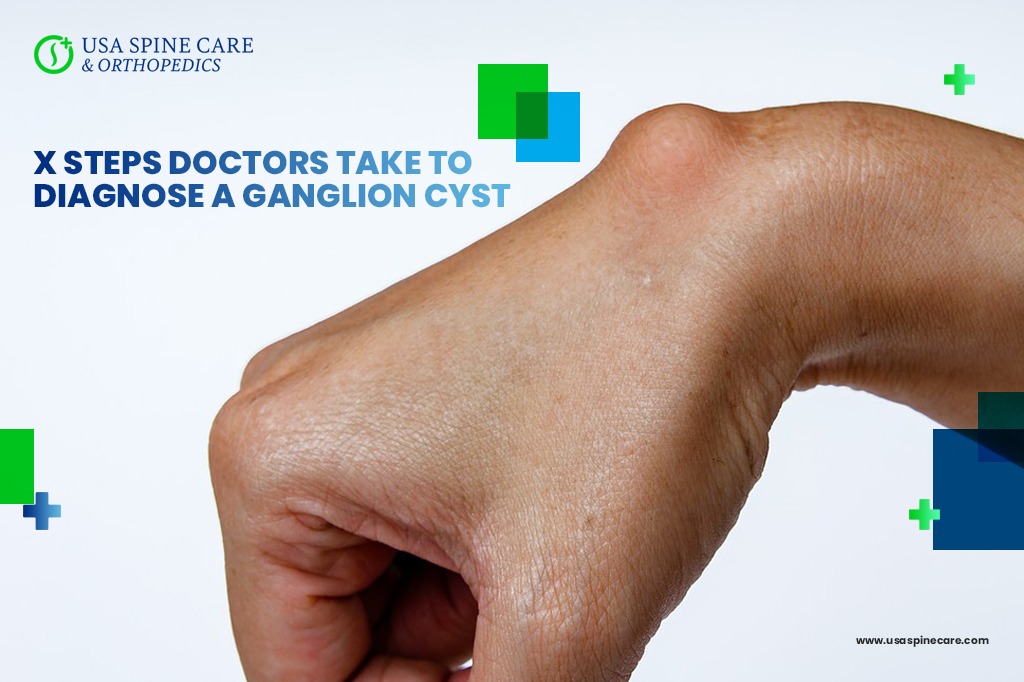- Conditions
- Procedures
- Patient care
- Why choose us
- Our Doctors
- Contact
Six Steps Doctors Take to Diagnose a Ganglion Cyst

A ganglion cyst is a type of noncancerous lump that develops on the back of the hand. This is the most common form of lump or mass that develops on the hand. It is often not painful and not seen as harmful. In many cases, they can go away on their own.
However, patients who develop a growth on the hand should never assume it is a ganglion cyst without receiving a professional diagnosis from a qualified physician. To help you better understand how physicians diagnose a ganglion cyst, take a moment to read the following step-by-step guide.
Understanding this important process can help relieve anxiety when you meet with your doctor and help you be more engaged in the treatment process. If you have any questions, please feel free to reach out to us at any time.
- Review medical history
A key part of how doctors diagnose a ganglion cyst is discussing your medical medical history. When meeting with a physician to diagnose any condition or injury, a medical history review can help doctors understand if there is a predisposition toward certain issues among the patient or the family.
It is also extremely important for the broader treatment process to determine whether a patient has any allergies or preexisting conditions that would cause a negative response to certain therapies.
- Discuss symptoms and how they are affecting daily activities
The next step to diagnose a ganglion cyst will be the physician asking how long ago the growth developed. It will also be important for him or her to determine whether it is causing pain or interfering with daily activities. In most cases, treatment, up to and including surgical removal, is only necessary if there is pain or if there are serious cosmetic concerns.
Your doctor may also ask questions about your profession and lifestyle to determine if there are any sports or movements that could potentially be contributing to the growth.
- Perform a careful physical examination
The next step will generally be a hands-on examination of the growth. This should involve the doctor carefully palpating and putting pressure on the lump. The primary goal is to test for hardness or to check for tender areas.
- Shine a line to test for translucence
Another common evaluation step is to shine a small light on it to check for translucence. This is because ganglion cysts are generally filled with a clear fluid. If the light shines through the cyst, it is a good way to confirm diagnosis of a ganglion cyst.
- Order diagnostic testing
Diagnostic imagery may be needed to rule out another condition or identify whether a ganglion cyst is present beneath the skin. X-rays are often used, because even though this form of imagery cannot see the cyst itself, it can be helpful to rule out other issues, such as a bone tumor or even arthritis.
Magnetic resonance imagery (MRI) or ultrasound are two diagnostic tools that do have the capabilities necessary to positively identify a ganglion cyst. This is particularly true if it is present beneath the skin, which is known as an occult ganglion cyst.
- Recommend appropriate treatments
If these diagnostic steps result in the positive identification of a ganglion cyst, the next step will be to develop a treatment plan. In a high number of cases, a non painful cyst simply requires a period of observation. In other cases, periods of rest and activity modification can help relieve symptoms, along with over-the-counter medication as needed.
If the cyst continues growing and causes swelling or discomfort, aspiration, or draining the fluid from the cyst can be an effective treatment.
When is surgical treatment or removal necessary for a ganglion cyst?
Surgical removal of a ganglion cyst can become a serious consideration if pain and other symptoms are interfering with quality of life. This includes disruption of normal daily activities and inability to perform work-related tasks or enjoy hobbies. Surgery can also become a possibility if the cyst grows back after draining. Finally patients often opt for surgical treatment for cosmetic reasons if there are serious concerns regarding the appearance of the cyst.
In surgical treatment for a ganglion cyst, the surgeon will typically access the hand or wrist and remove the cyst. This sometimes requires the removal of a portion of soft tissue that the cyst is attached to, including the tendon sheath or joint capsule, to ensure it does not grow back. Ganglion cyst removal can be performed as an outpatient procedure due to the development of minimally invasive techniques. Recovery time varies, with most patients requiring a rehabilitation of two to six weeks in many cases before full regular activities can be resumed.
Reach out to USA Spine Care today for information on ganglion cyst diagnosis and treatment
To learn more about conservative and surgical treatments for ganglion cyst, including ganglion cyst removal, contact USA Spine Care today. Our experienced and highly dedicated treatment team has years of experience helping patients overcome pain and mobility issues to regain a healthy and active lifestyle. We take a holistic interdisciplinary approach designed to provide individualized care that is right-sized for each patient’s needs.
Call toll free 1- 813-492-2512
